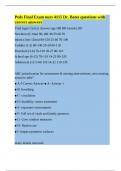Peds Final Exam nurs 4115 Dr. Bates questions with
correct answers
Vital signs Correct Answer-age HR RR Systolic BP
Newborn (0-1mo) 80-180 30-55 60-70
Infant (1mo-12mo) 80-150 25-40 70-100
Toddler (1-3) 80-140 20-30 80-110
Preschool (3-6) 70-120 18-27 80-110
School age (6-12) 70-110 14-22 80-120
Adolescent (12+) 60-110 14-22 110-120
ABC prioritization for assessment & nursing interventions, next nursing
action to take?
⦁ A-I Correct Answer-⦁ A- Airway- i
⦁ B- breathing
⦁ C- circulation
⦁ D- disability- neuro assesment
⦁ E- exposure/ environment
⦁ F- Full set of vitals and family presence
⦁ G- Give comfort measures
⦁ H- Head to toe
⦁ I- Inspect posterior surfaces
many details removed
,⦁ What p/t to see first: Correct Answer-⦁ ABC, age (younger first),
stable vs unstable, acute vs chronic (ussually acute), scheduled for
surgery or post op, VS, complications, discharge date (lowest priority)
⦁ When to contact provider? Correct Answer-⦁ Contact the provider for
any abn labs, worsening s/s, something new to tell them, need an order
before you can do something, side effects or adverse reactions
When to use the FLACC scale & what is assessed on it. Correct Answer-
⦁ FLACC- Nurses looks and grades, low score is better (0-10), each
worth 2 points
⦁ F- face: smile vs cry
⦁ L- legs: relaxed, kicking, fetal position, flexed
⦁ A- activity: normal to squirming
⦁ C- cry: crying or not crying
⦁ C- consolibility: can the child be calmed down, relaxed to difficult to
comfort
⦁ Always use the same pain rating scale, FLACC is used for patients
who cant use the FACES scale yet developmentally, mainly infants,
toddlers, and preschoolers
Asthma manifestations Correct Answer-⦁ Clinical manifestations-
wheeze, if in respiratory distress presenting with wheezing and cyanosis
give rescue med aka corticosteroid, Productive cough, can give
Leukotriene receptor antagonists (allergies), Respiratory distress,
,Increased respiratory effort, Anxiety, and Stridor, can give Beta-2
adrenergic agonists (bronchodilator)
⦁ Getting better if when compared in assessment they get better, like
were retracting and now they arent
⦁ not better if going from wheezing to no sounds at all!
Cystic fibrosis management and why Correct Answer-⦁ Therapeutic
management-
⦁ 1. Pancreatic enzymes before, with or within 30 minutes after meals
⦁ They receive them due to decreased absorbtion, because enzymes have
a hard time reaching the GI tract
⦁ 2. High calorie, high protein diet, avoid fatty/greasy foods
⦁ 3. Vitamin supplements for A, D, E, & K (adek)
⦁ 4. Add extra salt to food during hot weather
⦁ They sweat out all their salt already so don't want them to loose more
⦁ 5. Breast feeding with supplemental formula
⦁ 6. Need IV access for antibiotics (pulmonary infections)
⦁ 7. Nebulizer treatments or aerosol therapy with chest PT, 3-4x/day.
⦁ Due to secretions and difficulty breathing
⦁ 8. Change diapers ASAP after BMs (high fat content is irritating to
skin)
⦁ -teach they can play sports they enjoy
⦁ -postural drainage, suction would need to be before meals so that they
can enjoy their meal
, Larynotracheobronchitis- (croup) treatment and why Correct Answer-⦁
Therapeutic management-
⦁ teach parent to sit in a steamy bathroom with the child, or get cold air
outside or from freezer, use a cool mist humidifier in the hospital, then
corticosteroid, racemic epinephrine by nebulizer (rescue), IVF, mist tent
(make ure to change sheets because they et wet and will make the baby
cold)
Epiglottitis manifestations and interventions Correct Answer-⦁
Assessment & findings
⦁ enlarged epiglotis, drooling, increased respiratory distress, sitting
forward with neck extended, anxious, no cough
⦁ On assessment never use tongue blade, because it will close of throat
completely
Trach care post op Correct Answer-⦁ Assessment & interventions after
placement of tracheostomy in OR
⦁ After they get one in the OR everything is sterile, so do sterile
cleaning with sterile gloves, new kit, use new suction catheters
⦁ may not have inner cannula because they have narrower airways,
always do sterile suction (you suction when you can hear secretions,
crackles, rales, wheeze, see secretions) always have a smaller and same
size trach, suction, lube, ties, and ambu bag at bedside, may need suction
if decreased breath sounds, or can't get cough out, may need O2 prn
⦁ Should be clear, clean and free of secretions
⦁ Stoma should be pale pink




